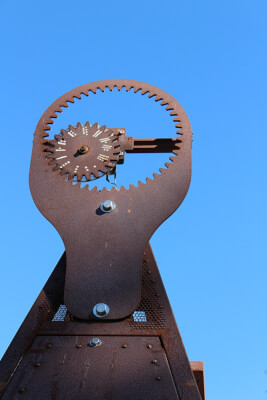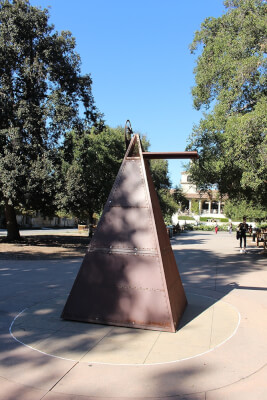
Artist Beatriz Cortez installed “Tzolk’in,” a large steel structure modeled after the Mayan agricultural calendar, in the middle of the Academic Quad Nov. 12. Cortez initially created “Tzolk’in” as two separate structures, one of which was displayed at the Hammer Museum’s Made in L.A. 2018 exhibition. The second structure was at The Bowtie Project in Glassell Park until Nov. 12, after which it was moved to Occidental as part of the Oxy Arts Speaker Series on multidisciplinary LA-based artists. According to Cortez, the contrasting locations of the structures show that even a Westwood museum and a Glassell Park former rail yard can be connected through the voices and experiences of everyday people.
A separate multi-platform storytelling project called “South of Fletcher: Stories from the Bowtie” was on display in Weingart Gallery this fall, and Cortez hopes that the two structures reveal a similar narrative of immigrant work across LA.
“[‘Tzolk’in’] enters into conversation with the photographs that were on exhibition because those were also, in a visual way, seeking to recreate the patina [the brown film on the surface of bronze and similar metals] that is embedded on the piece,” Cortez said.
Cortez immigrated to Los Angeles from El Salvador in 1989. She is a writer and professor of Central American Studies at California State University, Northridge as well as a self-trained artist. Cortez believes that “Tzolk’in” partially serves to honor the dedication, strength and flexibility that it takes to survive as an immigrant. The structure is cycloidal because a small wheel spins within a larger hole at the top of the triangular structure while simultaneously moving up and down.

“It is important to honor the Maya and to question people that deliberately make an effort to always imagine indigenous peoples as part of the past and never a part of the future,” Cortez said.
The notion of circular and linear motion is an advanced component of Cortez’s work because it appears industrially, as in factories; biologically, as in bacteria that moves like a helix in the body; and astronomically, as planets that move in linear patterns. Cortez believes that aspects of her work, like cycloidal motion or immigrant labor, can be applied to the cultures of many marginalized people and how they determine their future.
“The Mayan agricultural calendar is used to predict people’s destiny like horoscopes in the Western world; it has sacred connotations because it can guide you on your destiny and help you to know your power and energy,” Cortez said.
Sandy Pattison (senior) was drawn to Cortez’s way of incorporating cycloidal motion into “Tzolk’in.”
“Aesthetically, it caught my eye because the linear motion and circular motion use is really interesting since this goes all the way back to biology,” Pattison said. “It makes me connect art and science and ways that we don’t think about a lot.”
Various events of the past help shape the continuous meaning that Cortez and viewers can find in “Tzolk’in.” As a self-trained artist, Cortez embodies the difficulty of having to perform labor that she was not trained to do.
“As we were installing [‘Tzolk’in’], I kept saying it would have been a lot easier if we had made it differently, and that’s true, but it’s important that we didn’t change it because we improvised like an immigrant might have to,” Cortez said.
“Tzolk’in” is intentionally built of steel to mark the labor and the improvisation that comes with making art. As an artist, Cortez sees steel as an organic material because it still shows marks two days after someone touches it. Cortez hopes this is evidence that her work is alive.
These properties of “Tzolk’in” allow for the structure to never be fully complete because its viewers create the meaning literally through their hands and bodies throughout the day. Caroline Shehan (senior) believes that the deliberate creation process of “Tzolk’in” made it more therapeutic in its delivery.
“It makes the viewer more mindful and the viewing experience is so communal because here she is drawing people into the entire production and formally recognizing their efforts,” Shehan said. “It can be so easy for some artists to forget the laborers that helped them achieve their lauded product,”
According to Cortez, the structures aim to complement each other despite their distinct locations. At The Bowtie, “Tzolk’in” represents the unnoticed manual labor of the local Latinx community whereas its sister structure, located at the Hammar Museum, represents an international phenomenon. Additionally, The Hammar Museum’s description of Cortez’s work explains that the two structures are connected — live images of the structure at The Bowtie can be seen at the Hammer Museum. The structures’ constant connection despite their physical separation aims to represent the unique experiences of those living in different places while acknowledging connections that transcend space and time.
Cortez discussed the symbolic relevance of “Tzolk’in.” A Guatemalan-Mayan woman named Claudia Gonzalez was killed crossing the US-Mexico border the same day that Cortez and other laborers were installing “Tzolk’in” in The Bowtie Project. Gonzalez was fatally shot near Rio Bravo, Texas.
“It was incredibly painful for me to be installing my art on the same day that a woman of Mayan heritage in search of a different life was shot crossing the border by a different river,” Cortez said.
According to Cortez, the location of “Tzolk’in” next to the LA River was purposeful in that many immigrants have to cross land borders, rivers and other more violent obstacles to reach their destination. They lean against plants and other structures made of metals to observe their surroundings much like Occidental students can on the quad when viewing “Tzolk’in.”
“I wanted to give futurism in this sculpture as an omen to the Maya,” Cortez said.
Beatriz Cortez will return to Occidental Feb. 7 as part of the Oxy Arts Speaker Series.
![]()


































